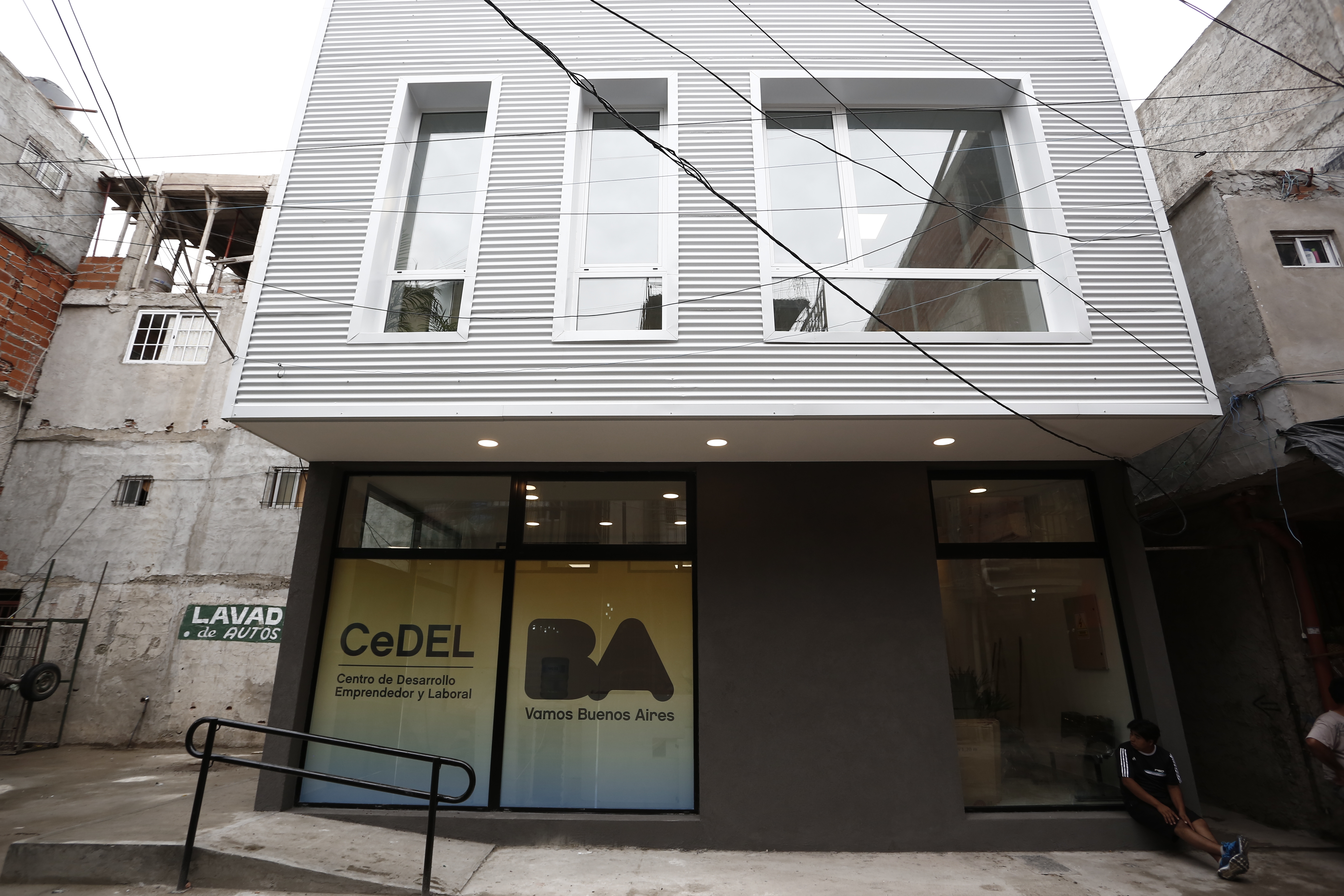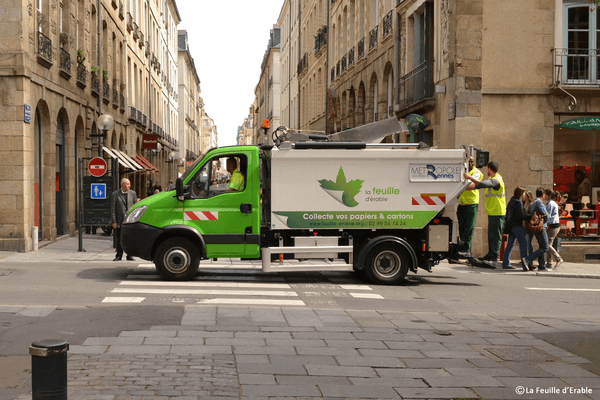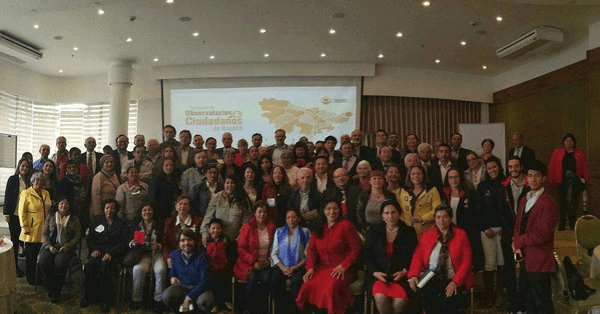 The urbanization of Villa 31, an informal settlement in Buenos Aires, Buenos Aires (Ciudad), Argentina - © Buenos Aires City Government
The urbanization of Villa 31, an informal settlement in Buenos Aires, Buenos Aires (Ciudad), Argentina - © Buenos Aires City Government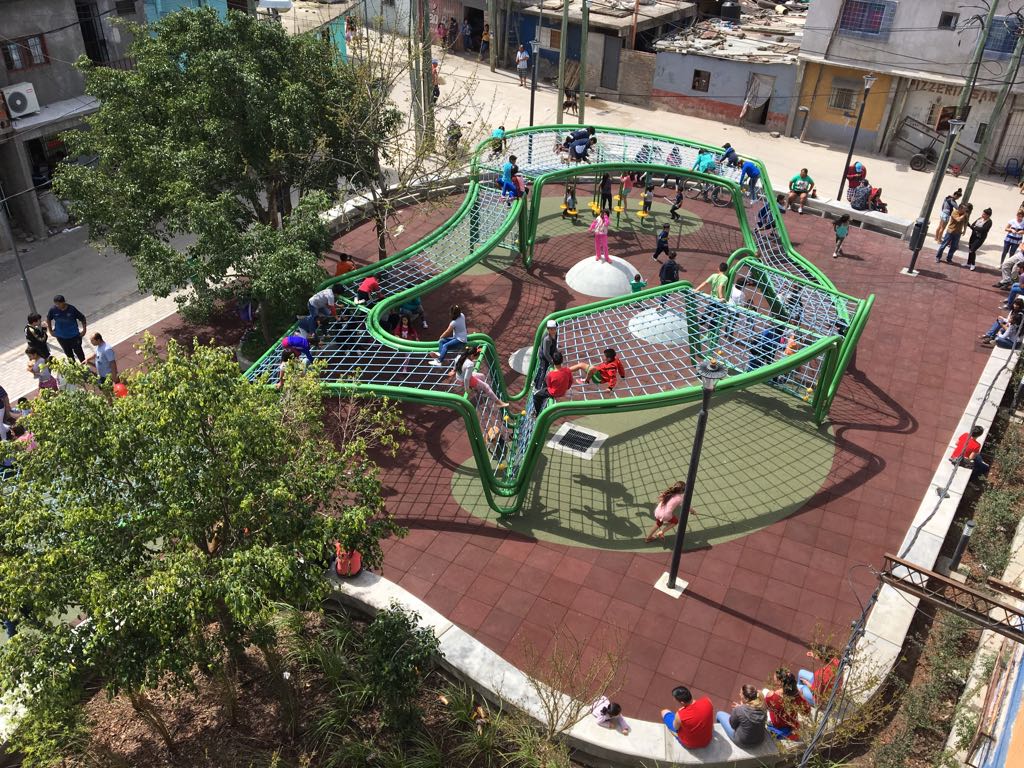 New playground in Barrio 31 - © Buenos Aires City Government
New playground in Barrio 31 - © Buenos Aires City Government New Housing development - © Buenos Aires City Government
New Housing development - © Buenos Aires City Government New Football field - © Buenos Aires City Government
New Football field - © Buenos Aires City Government- CeDel building - © Buenos Aires City Government
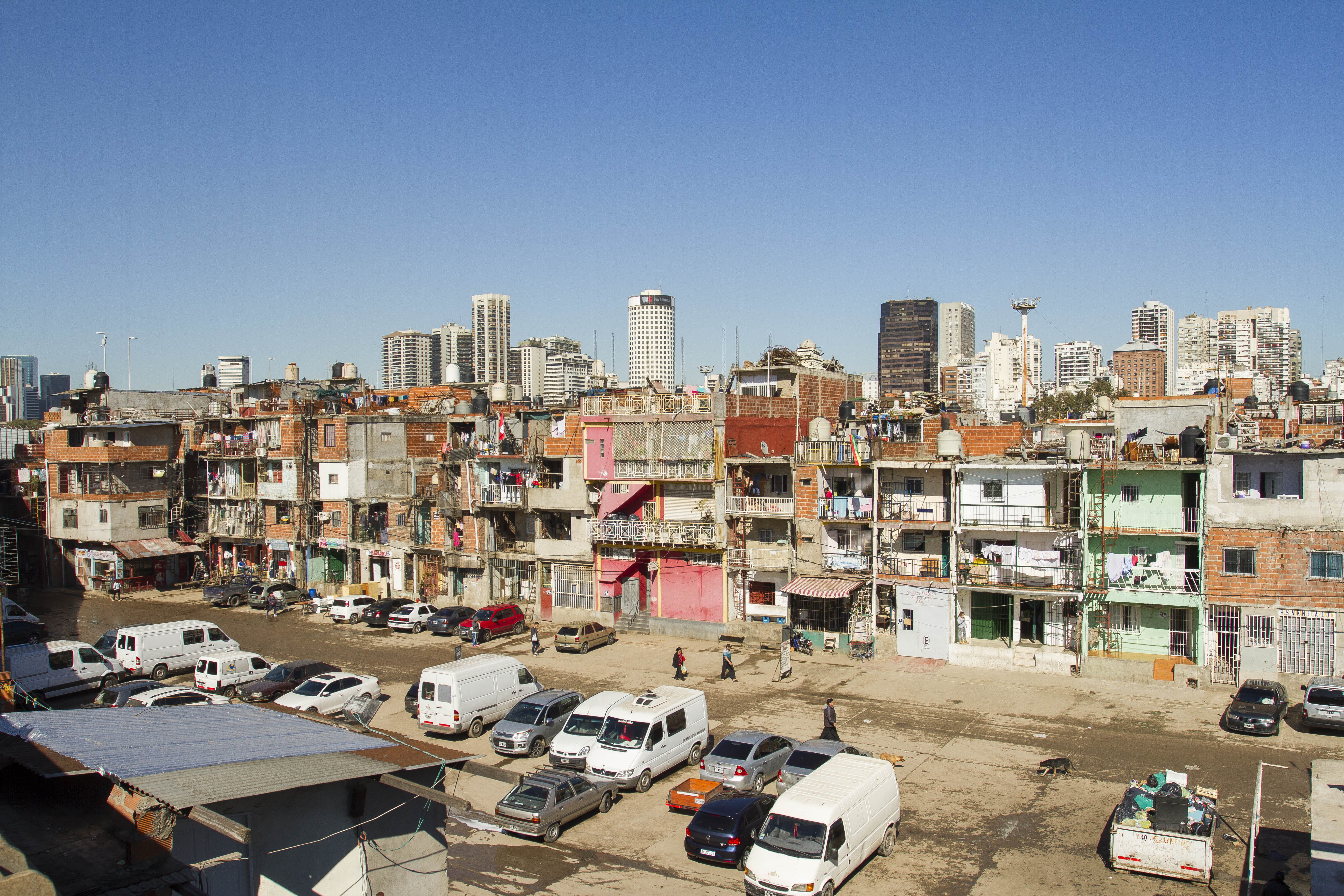 Barrio 31 aerial view - © Buenos Aires City Government
Barrio 31 aerial view - © Buenos Aires City Government Market - © Buenos Aires City Government
Market - © Buenos Aires City Government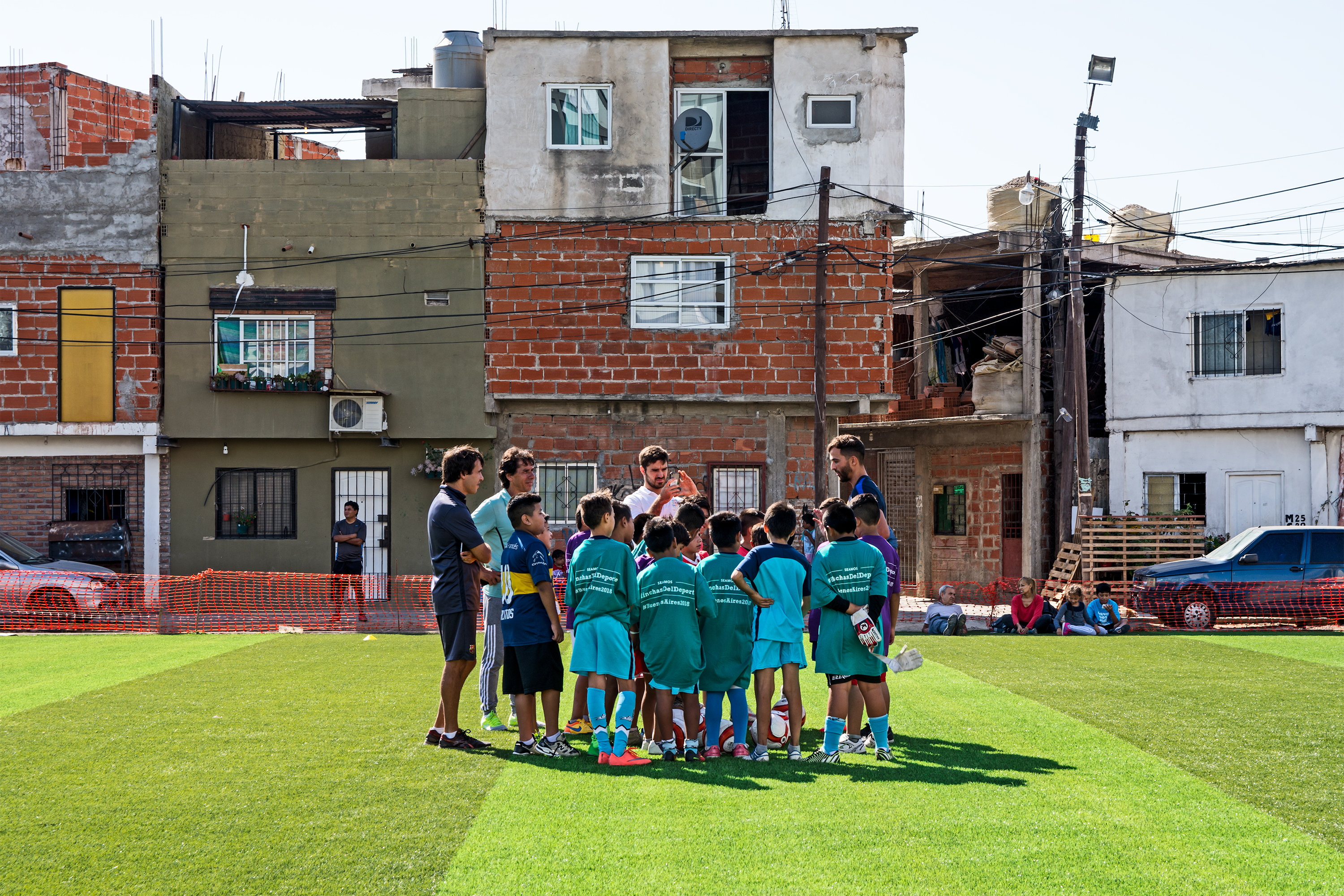 New sports facilicites for everyone - © Buenos Aires City Government
New sports facilicites for everyone - © Buenos Aires City Government
City
Buenos Aires
Main actors
City Government, National Government, Supranational / Intergovernmental Institutions, Community / Citizen Group
Project area
Neighborhood or district
Duration
Ongoing since 2016
Integrating a large informal settlement to the City’s urban, social and economic fabric.
The Barrio Mugica Integration Plan is aimed at integrating the most emblematic informal settlement in Argentina to the rest of the City of Buenos Aires. It is based on a holistic and comprehensive approach, meaning that several issues, including the lack of adequate access to public services, deficiencies in habitat conditions and socio-economic aspects such as non-registered work and substandard levels of education and access to healthcare, are tackled simultaneously. This plan is based on a set of policies that include the construction of infrastructure (sewages, drainages, drinking water and electrical connections, paving of streets and public lighting), renovation of public spaces, construction of more than 1,200 new houses, improvement of existing houses as well as the construction of schools, health centers and strategies to boost social and economic development. To do this, the Plan focuses both on rights and responsibilities, so that every resident living in Barrio Mugica is incorporated as a full citizen of the City of Buenos Aires.
Guangzhou Award
This project was shortlisted for the 'Guangzhou Award' in 2020 in the following category: Deserving Cities.
Barrio Mugica, formerly known as Villa 31, is one of the largest informal settlements in Buenos Aires, located in the heart of the city. It was first settled in the 1930’s by European migrants, and then expanded by internal migration and families moving in from neighboring countries. Currently, it covers approximately 72 hectares and houses 40,000 people. The neighbourhood hosts a very young population: 50% of its residents are younger than 24, and 70% are younger than 35 years old. At the same time, only 1,9% of the population is older than 64.
Most governments tried to eradicate the settlement, almost succeeding in the 1970’s. However, these experiences proved that eradication and resettlement kilometers away from the neighborhood offered no real solution to the issues residents faced: Barrio Mugica’s indicators were consistently lower than those of the city in terms of habitability, health, education and economic development. Through works in infrastructure, housing conditions, and implementing policies to improve access to education, healthcare and boost economic development, Barrio Mugica is on the path of becoming an integrated part of the city.
The objectives of the Barrio Mugica initiative are:
- Urban integration; guarantee access to all basic services and connectivity through infrastructure and environment-friendly public spaces.
- Habitat; improve the living environment for all residents by developing adequate and safe housing.
- Social integration; improve access to quality public education and health services, as well as promoting cultural and community activities.
- Sustainable economic integration; formalize and empower businesses and entrepreneurs in Barrio Mugica.
The implementation plan is guided by the project objectives and the development pillars of the City Government. The key is the holistic approach: tackling multiple issues at the same time. Implementation began in 2016, after the creation of a specific unit within the government, the Secretariat of Social & Urban Integration, to manage the project.
Urban Integration
A key pillar of this integration plan is the construction of the necessary infrastructure so that all residents can have access to public services. This objective refers to the connection of the neighborhood’s infrastructure network with that of the city.
At the same time, access roads were improved and the frequency of public transportation services was increased to improve internal and external connectivity with the City.
In addition, to improve the quality of life and contribute to the sustainability of the neighborhood, 26 existing public spaces and sports courts were renovated, and new green and recreational spaces were created. This will help reduce environmental pollution and encourage the practice of leisure and recreational activities that have a positive impact on the health of residents.
Finally, one of the most significant changes will be the creation of a new park that will transform the area located under the Illia Highway, cutting across the neighborhood, where more than 1,000 families once lived, into a public space.
Habitat
The objective is to have every single resident living in a safe, accessible and adequate home. The program has two strategies: improving existing structures and constructing new housing.
The first strategy to improve the habitability conditions of the neighborhood is through the Housing Improvement Program. It covers both the exterior and the interior of existing homes: improving facilities, accesses, openings and waterproofing. This is a central policy, since this project does not seek to rebuild the neighborhood from scratch but starts with the refurbishment and improvement of what already exists.
A second strategy is the construction of new housing. More than 1,200 new homes were built to resettle those families whose houses can’t be improved, especially those currently living under the Illia Highway.
Social Integration
For this integration project works are only a means to achieve what is most important: social integration. This includes access to health and quality public education.
In terms of education, the goal is to find a seat in a classroom for each child and also to develop alternatives so that all adults can find spaces to finish school, regardless of their age.
When this project began, this was impossible: there was no public school in the neighborhood. For this reason, during the first four years the focus was specifically on changing this situation. For this, 3 new schools were built with vacancies at kindergarten, primary school and an adult education center. Next to the schools is the Ministry of Education of the City, this brings a huge commercial movement to the neighborhood and brings public policies to where they are most needed.
The lack of access to the formal health system contributed to the infrastructure and habitat conditions, generating serious problems for the residents. For this reason, from the beginning of the project, close and good quality health care, and the promotion of healthy lifestyle habits, were central objectives.
Today, the neighborhood has 2 new health centers, strategically located, and one more completely renovated. This ensures all residents have access to primary health care close to their homes.
The city government also set up a SAME (Emergency Medical Care System) base, where an ambulance is available 24 hours a day to attend to any emergency in the neighborhood and the area.
Sustainable Economic Development
The unplanned urban growth that occurred for decades in the Mugica neighborhood brought with it the informal growth of its economy. Of the economically active population, half earn their income informally and the lack of training options created even fewer opportunities to enter the labor market.
For this reason, another objective of the integration of the neighborhood is to integrate its economic matrix with that of the city. To achieve this, the government works on public policies with a transversal perspective where all the actors of the economy are considered: entrepreneurs, merchants, fairgrounds, and those looking for work.
All these policies are centralized in the CeDEL (Center for Entrepreneurial and Labor Development), where residents come for advice and training. Specifically, it works on labor integration, training in trades, formalization and financial inclusion and advice to entrepreneurs.
The lead agency for the project is the city government of Buenos Aires with the World Bank and the Inter-American Development Bank providing funding for specific projects and technical support. Specifically, the Inter-American Development Bank provides funding for programs such as improvement of public spaces, improvement of existing households, the new headquarters of the Ministry of Education and community engagement programs. The World Bank provides funding for public service infrastructure, including the re-adaptation of existing sewers and storm water networks; new housing and basic services infrastructure; medium and high-voltage electricity and community engagement programs.
The Plan’s total budget (2016-2020) stands at 342 million U.S. Dollars. Disaggregated, 30.5% consists of local government funds, 49.5% to a 169.5 million credit by the World Bank and 20% to a 69 million credit by the IDB.
Barrio Mugica integration project addresses all dimensions of human development, through the implementation of multiple intertwined policies. Thus, over the past four years and a half, the City Government has been able to achieve numerous results and impacts.
Housing and infrastructure:
- 17,700 linear meters of infrastructure were built to provide basic services (sewage, drainage, pavement, public lighting, electricity and drinking water)
- 2,225 people have already been resettled to new houses within the neighborhood and have been provided with a property title.
- 1,154 new housing units were built for the residents
- 1,732 houses received housing improvements
- 27 public spaces have been upgraded.
Social integration:
- 3 new schools were built, and 1 school was improved, offering more than 2,600 new school seats
- The new Ministry of Education headquarters was built and inaugurated, in January 2020
- 565 teenagers participated in the 2019-2020 edition of “Estudiar es Elegir tu Futuro” (Studying to Choose your Future), a program that offers training in cognitive abilities together with tutoring and follow-ups in order to strengthen secondary education completion
- 2 new health centers were built and 1 was remodeled. All of them were located strategically in order to guarantee all residents of Barrio 31 have access to a health center within a 15-minute walk from their homes
- 20,386 residents have participated in cultural activities organized by the City Government
- Over 5,000 residents have participated in gender equity and empowerment activities
- More than 4,000 participatory meetings have been carried out.
Economic development:
- 63% of the labour force participated in trainings and mentoring in the CeDEL
- 900 people were hired through the CeDEL’s Job Exchange
- 123 companies are acting as strategic partners offering jobs and training
- 223 entrepreneurs were trained, empowered and mentored
- 180 entrepreneurs received micro credits to improve their businesses
Sustainability
Any urban renovation project, especially when dealing with informal settlements, must take into account the possibility of gentrification. This is particularly true in Barrio Mugica, where the land has always been sought by the City’s real estate market -as it is located next to the highest-income neighborhoods in Buenos Aires.
To create lasting change and make the Integration Project sustainable, the City Government worked together with residents and the City Legislature to create a legal and regulatory framework that mitigates the possibility of gentrification. City Law 6,129 effectively amended the city’s planning code, establishing strict limits in land plot sizes, heights, total square meters of construction, and land uses. Due to these regulations, specific for Barrio 31, it is no longer possible to build large skyscrapers or commercial buildings -as the maximum height allowed is just 4 stories, maximum area to be constructed is 250 m2, which is lower than the minimum in the rest of the City- and 80% out of the total area must be reserved for residential structures.
Also, to further avoid gentrification, a special arrangement was put in place to ensure the City Government has the right to buy the properties -once formalized- from those residents wanting to sell them. This way no company or realtor can pressure residents to sell their homes and then redevelop. All of this builds on a previous and historic process: the formalization of property and granting of land deeds after close to 90 years of informality, together with the regularization of public services, as connections to water and electricity were also informal.
However, land regulation is not the only aspect that has to be considered when thinking about sustainability. The Barrio Mugica Project also focuses on economic development as a key to boost resident’s incomes. Through training courses to improve accounting practices, business management and marketing, by creating a network of entrepreneurs who share their experiences and advice, supporting small businesses’ financial inclusion and also helping individual residents get formal jobs, the City Government looks to advance the neighborhood’s economic development and integration of its economy with the City.
Another key to sustainability is participation. By making residents part of the policy process, improvements are better adopted by them, relationships with the government and the City improve, and responsibilities are better shared among all actors involved.
Awards:
- UNESCO Netexplo Linking Cities Forum 2021, Habitat category, awarded to the City of Buenos Aires for the Barrio 31 Project.
- World Economic Forum Lighthouse Project 2020 (Geopolitics - Regional Development and Cohesion category), awarded to KPMG consulting company for their role as advisor in the Project.
- World Smart City Awards 2019 (Inclusive & Sharing Cities category), awarded to the City of Buenos Aires for the Barrio 31 Project.
- Global Steering Group for Impact Investing (GSG) Honors Awards 2019 (Impact Market Builder of the Year category), awarded to the City of Buenos Aires for the Barrio 31 Project
- Honorary Mention, Green Solutions Awards 2019 (Sustainable Districts Grand Prizes category), awarded for the new housing project.
- Roger Kaufman Award for Societal Impact (2018), awarded to Diego Fernández in his capacity as Secretary of Social & Urban Integration.
- 68% of residents do not have a secondary education, therefore it is difficult for them, and the economic team, to help them find formal employment that will provide health, maternity and pension benefits. Discrimination is also a major issue residents face when it comes to finding a formal job.
- The proportion of informal renters is approximately 30-40% and subsequently makes the improvement of housing and land regularization a challenge.
- The lack on ventilation in houses provides a challenge for landlords to guarantee basic housing standards to residents.
- The housing structures, size and division of land make it difficult to provide property titles to residents according to the urban planning code.
- The layout of streets and urban space make accessibility for construction companies to use the required machinery for infrastructure upgrades and housing works complex.
- The risk of gentrification needs to be managed to prevent existing resident from being displaced, however, at the same time ensure that moving forward Villa 31 has a social makeup similar to formal neighborhoods.
The Barrio Mugica Project is one of the few integration projects focusing on informal settlements located in the center of a global city. It is also one of the few, if not the only one, that addresses all the areas mentioned simultaneously, without resettling the entire neighborhood away from where they have lived for years. That is why the City Government works to document and evaluate the advance of the Project, knowing that it can serve as a benchmark case for many cities and towns around the world. The World Bank and the IDB also work towards this objective, as it is uncommon to find both institutions supporting the same project. A highlight of this is that not only are best practices documented, but also those policies that faced difficulties in any of their implementation stages. As the Project is unique, it could be of great value to any other City to learn from Buenos Aires’ experience in Barrio Mugica, both what worked and what did not.
However, it could also be difficult for many cities to secure the funding necessary to replicate the project as a whole. Because of this, the city government is currently working to document individual best practices, around each of the key areas of work. The participation model was designed to agree renovations on public spaces together with residents, the Entrepreneurial & Labor Development Center, the Housing Improvement Program, and many other policies can be replicated individually, building on Barrio Mugica’s experience.
At the international level, the experience can be replicated through the exchange of good practices, within the framework of the technical cooperation instruments provided by the Union Of Ibero-American Capital Cities (UCCI), such as: specialized training, technical assistance, and support to local research projects.
On Map
The Map will be displayed after accepting cookie policy
